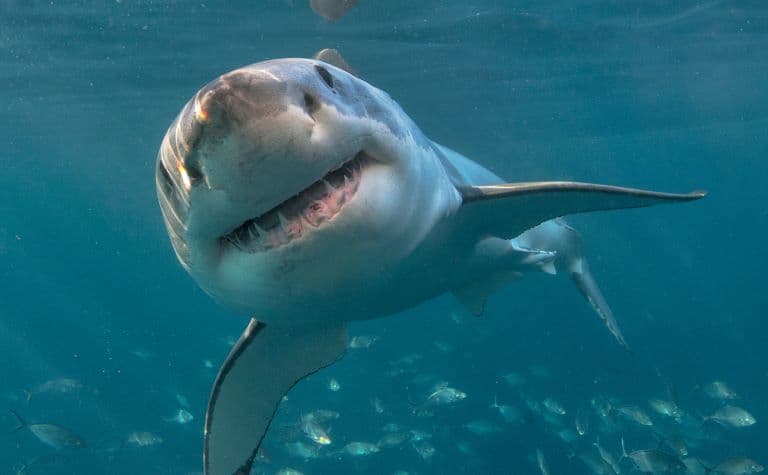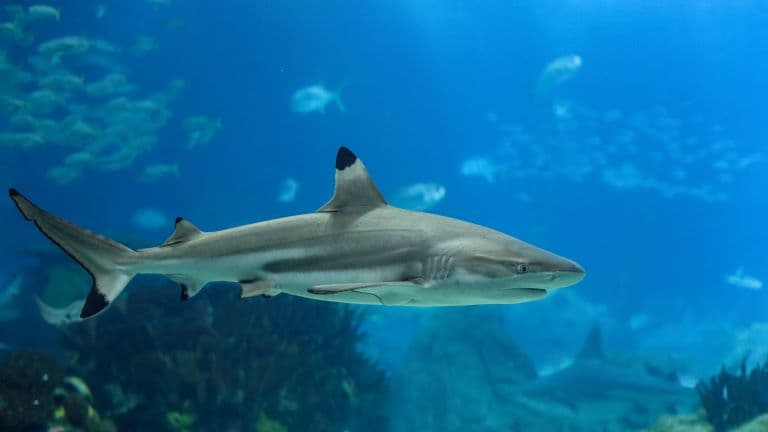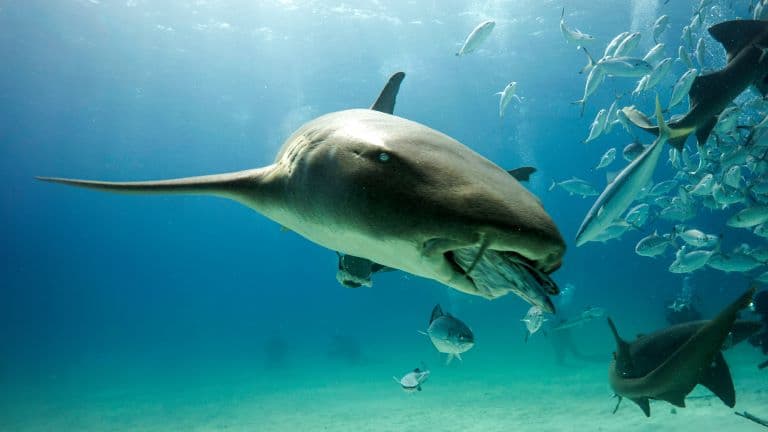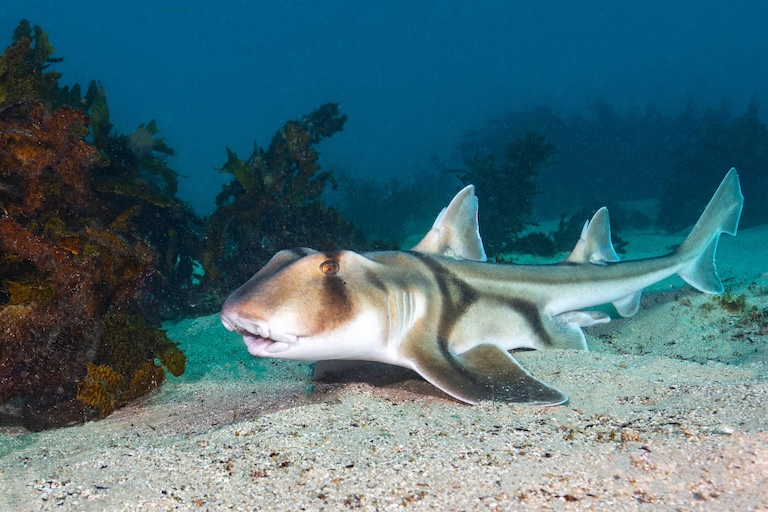Sharks Profile
Historically referred to as “sea dogs” this nickname is perhaps more accurate than it appears. Sharks are tenacious, top-tier predators that occupy three-dimensional niches in every single ocean and sea on Earth. They can hunt in packs or alone and have complex social hierarchies.
Despite relentless destruction at the hands of the international fishing industry, there may still be a billion sharks left, and it’s thought over 400 species are remaining. Sharks are some of the most successful animals of all time, beginning their ascent roughly 450 million years ago and maintaining the position of apex predator through five mass extinction events.
Unfortunately, without our help, the sixth one is likely to be the kicker.

Sharks Facts Overview
| Habitat: | Marine, some freshwater |
| Location: | Worldwide |
| Lifespan: | Over 200 years |
| Size: | Up to 18 meters (60 ft) |
| Weight: | Up to 20 tons (44,000 lb) |
| Colour: | Green/blue, sometimes patterned |
| Diet: | Usually carnivorous predators; sometimes plankton |
| Predators: | Other sharks, orcas, humans |
| Top Speed: | Possibly up to 74km/h (45 mph) – debateable! |
| No. of Species: | Over 400 |
| Conservation Status: | One-third or more threatened with extinction |
Sharks are some of the most successful animals in the history of life, having relied on exceptional biodiversity and adaptability to thrive through countless dying events. While many are still going strong, their numbers have declined significantly over the last five decades, and this ancient engine is beginning to sputter as more species are threatened with extinction.
But this extinction event isn’t a result of an asteroid impact or volcanic eruptions, or plants stealing all the CO2, this time it’s on us. And because we’re the cause, we have the power to avert it.
Interesting Sharks Facts
1. Taxonomy
Sharks are one of the three groups of animals we call “fish”. The ocean was once filled with animals with bendy skeletons. It’s thought that bony, more rigid frames evolved out of this cartilage and resulted in the two bony fish lineages we see today, the ray-finned fishes and the Sarcopterygians.
This suggested that sharks chose to stick with their cartilage instead of evolving to use bone, but recent fossil discoveries have put that into question, and it may well be that sharks once evolved bony skeletons and then lost them again later.
Regardless, while sharks, Sarcopterygians and ray-finned fishes look very similar they’re surprisingly unrelated. The three groups diverged over 400 million years ago, which is farther back in time than the divergence of humans and lungfish.
While the Sarcopterygians were pushed up onto land to become the tetrapods, the ray-finned fishes and the cartilaginous fishes remain dominant in the ocean and sharks now represent over 400 species over thirteen orders of extant fishes.
There is an astounding diversity within the sharks: from filter-feeding behemoths like the whale shark, through active predators like the mako and the Great white, all the way down to parasitic cookie-cutter sharks; these animals live in every ocean and sea, from the shallow reefs to the deepest trenches, from tropical baths to frigid Antarctic waters.
The sheer number of species and diversity gives us clues as to how these incredible animals have survived so long and through so many catastrophic events. 1

2. Evolutionary history
The first evidence of shark-like scales comes from the Late Ordovician Period, around 450 million years ago (MYA). Almost immediately by geological time, sharks were hit with a mass extinction.
The Ordovician-Silurian mass extinction occurred 443 million years ago and wiped out approximately 85% of all species.
The first shark-like teeth we see in the fossil record show up in the Devonian period, at around 410 MYA. Around this time, shark diversity begins to really kick off, but is stunted by another mass extinction event that wiped out the vast majority of marine life and led into the Carboniferous period.
This proved to be good for sharks, who rode out this chaos and entered what’s known as the “Golden Age of Sharks”, during which populations and species exploded.
The third extinction event, the Permian extinction, happened around 250 million years ago and was the most devastating so far. 95% of all species perished in an event known as the “Great Dying”. This led to the rise of the dinosaurs and was followed, 50 million years later, by another one.
The Triassic extinction wiped out 80% of all species, but sharks still prevailed. Finally, the Cretaceous period ended with a bang, killing off 75% of all species and allowing mammals to diversify and increase in size.
Today, we’re in the midst of a sixth mass extinction event, caused by the ecological collapse and climate change resulting from human-released CO2 and widespread environmental destruction.
The sharks we know today have evolved through immense struggles that wiped out the vast majority of all lines of life. They represent one of the most successful groups of animals alive, and their survival is a testament to the power of biodiversity and adaptability. 2

3. Prehistoric sharks/weird examples
Over this time, they’ve evolved into a dazzling array of shapes and sizes, yet since their skeletons don’t fossilise, we’re left piecing together the image of prehistoric sharks mostly by their teeth.
Some bizarre examples that are no longer with us include Heliocoprion, whose fossilised teeth have led to some very imaginative and borderline idiotic artistic representations of what the shark may have looked like.
All that’s known about this shark comes from fossils of its coiled teeth and a partially preserved imprint of a dorsal fin. So, depictions of it are all over the place, but it certainly had a bizarre coil of teeth forming a whorl. The debate continues as to how this worked.
Another funny-faced shark was the Edestus genus, which shows up in the late Carboniferous and also had tooth whorls, forming a single row in its mouth. This shark has been dubbed the “scissor-toothed Shark” on account of its strange row of protruding teeth.
Artists’ impressions show it with a ducklike mouth, its rows of teeth sticking forward and away from one another. Hypotheses suggest that this would have been useful with a protruding jaw that would grab and pull prey into the rest of the teeth.
The 300-million-year-old Stecanthus has what appears to be a spinal protrusion that some think might have been inflatable. The surface of this protrusion was armoured, so it could have been defensive, or it could have been an attachment surface such as is found on remora fish. Regardless, drawings of it have the shark swimming around looking a lot like the E3 Sentry aircraft.
And then, of course, there was Megalodon. 3
4. The largest to ever live
The largest shark alive today is an enormous, plankton-feeding fish known as the whale shark. But these 18-meter gentle giants are dwarfed in both size and ferocity by the immense set of toothy jaws attributed to Otodus megalodon, a relatively recent arrival and the largest shark to have ever been found.
Again, we only know it from a piecemeal collection of teeth and a bit of some vertebrae, but the highest size estimates suggest that this predator would have been able to reach 20 meters in length, and certainly would have been larger than the average whale shark around today.
This would have been one of the most powerful predators to have ever lived, and it had wide, powerful teeth, similar to those of a great white, but significantly larger. High-end estimates place its bite force at ten times that of the largest white shark.
But Megalodon lived in the new age, after the dinosaurs, and during the rise of mammals. And as such, it had a lot of competition from toothed whales, which may well be why it’s not around anymore.
So, toward the more recent aeons of shark’s reign, mammals have played a significant part in their decline. This has never been truer than it is today, as the destructive harvesting of the oceans by a single species of ape puts unprecedented force on all of its inhabitants, but sharks have survived five mass extinction events already, and they have proved to be immensely resilient in doing so. 4

5. How they survived
The truth is, that not all sharks did survive.
In times of stability, specialists reign supreme. Being ridiculously good at one thing is a great strategy for as long as that one thing remains useful. But when there is turmoil, it’s the generalists who take over. Those who can eat anything and live anywhere and might not be as good at any one thing, but can adapt and grow under various situations.
And so it was with sharks, after each extinction event, the specialists died off and the generalists remained.
Species with the largest geographic range were more likely to survive, as did “newer” varieties; sharks that had more novel adaptations, rather than those that remained unchanged over the millions of years.
But it is the sheer diversity of species that ties all of this together and shows us why and how biodiversity is the key to the long-term survival of life and ecosystems, even through immense catastrophes.
6. Today’s diversity/examples
Today, we still see a good portion of that diversity. Sharks are present in every sea and ocean, and even in some of our rivers.
Hammerhead sharks are perhaps a great example to start with. These are essentially swimming metal detectors, capable of scanning the sand for the tiniest electrical signal coming from the nervous system of hidden fishes.
Then, there are the pelagic sharks; muscular, stiff and speedy animals like the shortfin mako, who spend a lot of time in the featureless abyss of the open ocean and migrate over immense distances.
But beneath them, sharks have occupied even stranger niches. The blackbelly lantern shark lives over a kilometre below the hammerheads, well under the photic zone. Where there is no natural light, these tiny, 40cm sharks make their own, and hunt cephalopods at crushing depths.
But deeper still, the Portuguese dogfish pushes the limit of what’s possible at depth, living as far down as 3.7 kilometres, and is the deepest known shark so far. But we have barely touched the surface of marine biodiversity, especially at great depths, so it’s unlikely to be the deepest-living shark there is.
All these sharks fill an important role in nutrient recycling and population control for their ecosystems and many are top predators.
Though, despite their persistence, they are now faced with unprecedented pressure and over a third of species are threatened with extinction. 5

7. Conservation statistics
A statistic from over a decade ago is still floating around as a fact today: over 100,000,000 sharks are killed each year by humans.
Since it came out, fish stocks have steadily reduced, and in response to this, there has only been an increase in fishing boats to compensate. This means more nets and more bycatch. So, the likelihood of this number being significantly higher by now is high.
Some estimates now put this number to around 273 million.
Humans are killing sharks faster than they can repopulate. Sharks reproduce slowly, and their loss is significant to their ecosystem.
Shark finning is the high-profile culprit, and is thought to be responsible for 50 million to 75 million shark deaths per year, but the dirty little secret is that this may be only half of the issue. Commercial fishing is possibly the single biggest threat to global biodiversity, and sharks are a testament to this.
Bycatch is the constant slaughter and indiscriminate eradication of species at all trophic levels. Tens of millions of sharks are caught in nets targeting our next meals, and they are not breeding fast enough to replenish their populations.
Sharks caught as bycatch are often killed and finned, so while it’s easy to blame those buying shark fin soup, a large proportion of the responsibility lies in those of us who are still eating seafood in general.
The result is that shark and ray populations have declined by over 70% in the last fifty years.
It might seem like a problem that’s too big to solve, but there are ways we can help.
8. How to help
There are numerous programs out there for sharks that need more attention. Save Our Seas has tips on how to reduce your impact on sharks through more conscientious purchases, and the Shark Conservation Fund is running 125 projects worldwide that welcome support of all kinds.
The Shark Trust suggests using your voice to help spread the message of shark conservation, and there are citizen science projects and fundraising events you can join for a more direct impact.
But the biggest thing a single person can do to help the Earth’s biodiversity, including sharks, is to move away from animal products like seafood.
We are pushing sharks through the sixth mass extinction event, and instead of a natural disaster, this is an intelligently designed eradication program. Biodiversity alone might not be enough to save them this time. 6
Sharks Fact-File Summary
Scientific Classification
| Kingdom: | Animalia |
| Phylum: | Chordata |
| Class: | Chondrichtyes |
| Order: | 8 Orders |
| Family: | 15-30 families |
| Sub class: | Elasmobranchii |
Fact Sources & References
- Hayley Dunning (2020), “Ancient bony fish forces rethink of how sharks evolved”, Imperial College London.
- Josh Davis, “Shark evolution: a 450 million year timeline”, Natural History Museum.
- Trista (2019), “A List of Ancient Sharks from Small to Scary”, Science Sensei.
- “Megalodon”, WikipediA.
- “Sharks”, ifaw.
- Lois Flounders, “How can I help sharks?”, worldofsharks.
